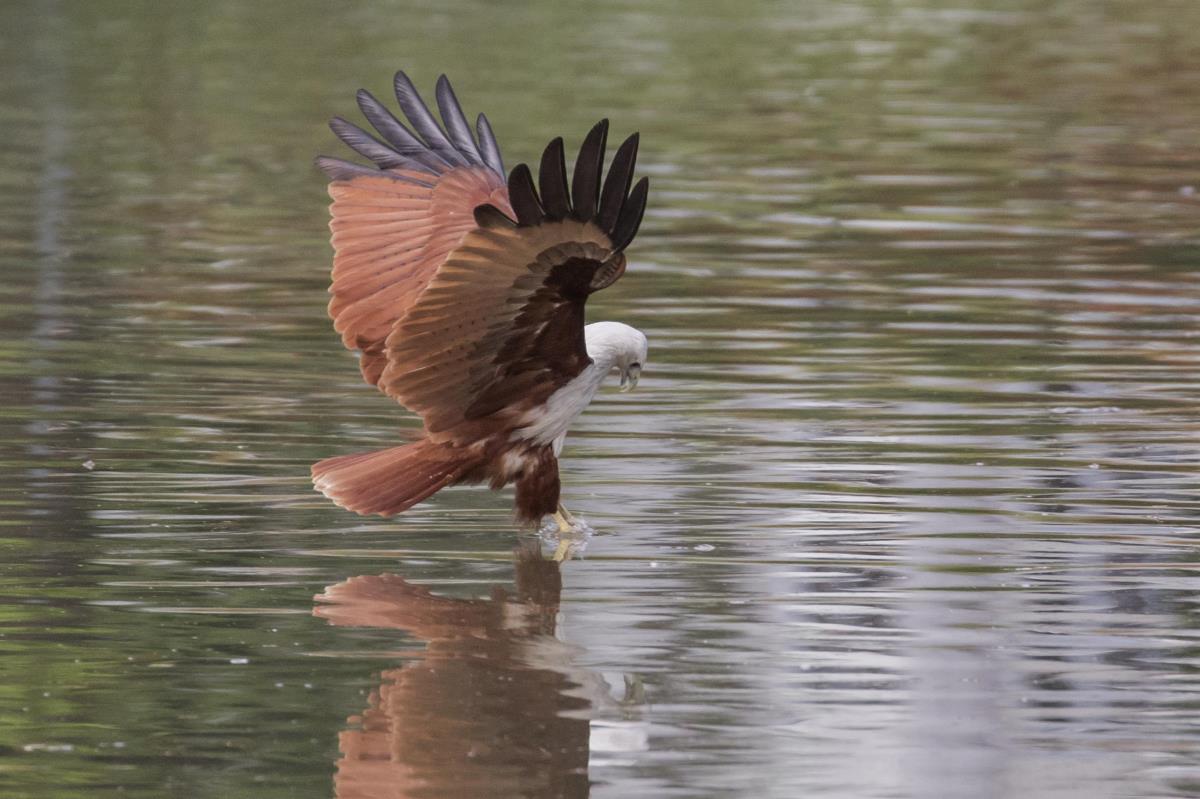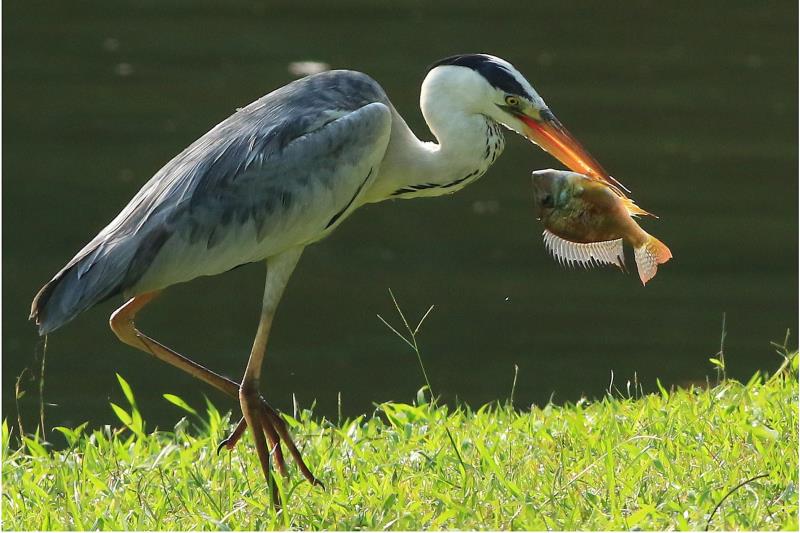Garden and Urban Birds of Jurong Lake Gardens
Singapore is home to many species of birds that have adapted to the city life, many of which frequent Jurong Lake Gardens.
Brown-throated Sunbird
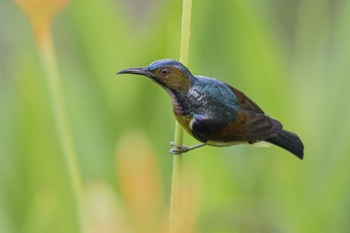 Male. Photo credit: Loke Peng Fai Male. Photo credit: Loke Peng Fai |
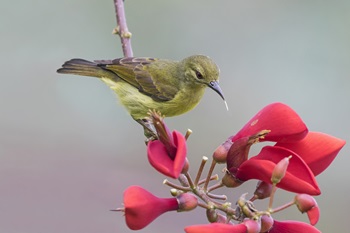 Female. Photo credit: Loke Peng Fai Female. Photo credit: Loke Peng Fai |
| Scientific name: | Anthreptes malacensis |
| Common name: | Brown-throated Sunbird |
| Family: | Nectariniidae |
 14 cm 14 cm
|
 What does it look like?
What does it look like?
While the Western Hemisphere has hummingbirds (Family Trochilidae), Africa and Asia have sunbirds, which are also primarily nectar-feeders. Brown-throated Sunbirds are relatively large compared to other sunbirds. Males have a brown throat, with a metallic green head and neck, purple wings and lemon yellow belly. The females are dull olive in colour. Both sexes have red eyes.
 Ecology, Habitat and Distribution
Ecology, Habitat and Distribution
Diet and Behaviour
Their primary diet is nectar, but they will also feed on invertebrates, particularly spiders. These birds are often seen visiting flowering trees and shrubs in search of nectar. Like other sunbirds, they make pouch-shaped nests that are suspended from tree branches using leaves, grass and spiders’ web.
Where are they found?
A very common sunbird, it is found in many habitats in Singapore and throughout Southeast Asia.
Olive-backed Sunbird
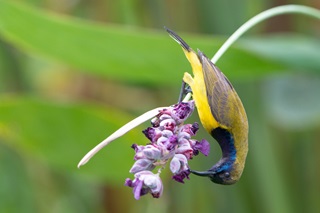 Male. Photo credit: Francis Yap Male. Photo credit: Francis Yap |
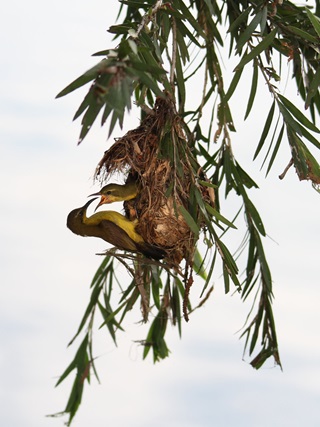 Female and chick in nest. Photo credit: Perlyn Chng Female and chick in nest. Photo credit: Perlyn Chng |
| Scientific name: | Cinnyris jugularis |
| Common name: | Olive-backed Sunbird |
| Family: | Nectariniidae |
 12 cm 12 cm
|
 What does it look like?
What does it look like?
In addition to the Brown-throated Sunbird, the Olive-backed Sunbird is the other sunbird that can be commonly seen in our parks and gardens. Both males and females have a dull olive brown back with yellow underparts, but the males also have a metallic blue forehead, throat and upper breast. This species has a longer, more curved beak than the Brown-throated Sunbird.
 Ecology, Habitat and Distribution
Ecology, Habitat and Distribution
Diet and Behaviour
They feed on nectar but will also prey on insects, especially when feeding their young. These birds are often seen in pairs visiting flowering shrubs and trees. They are more often seen in flowering shrubs compared to the Brown-throated Sunbird. Like other sunbirds, they make pouch-shaped nests that are suspended from tree branches using leaves, grass and spiders’ web.
Where are they found?
The Olive-backed Sunbird is very commonly seen in our urban areas and are very tolerant of humans. Some are even bold enough to make their nests on potted plants in HDB blocks! They are also found across southern China, Southeast Asia, northeast Australia and the Solomon Islands.
Did you know?
The nests of Olive-backed Sunbirds are often a source of fascination for Singaporeans as they regularly nest in residential areas such as balconies and along the corridors of HDB estates.
Scarlet-backed Flowerpecker
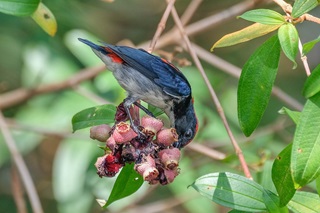 Male. Photo credit: Soh Chui Lian Male. Photo credit: Soh Chui Lian |
| Scientific name: | Dicaeum cruentatum |
| Common name: | Scarlet-backed Flowerpecker |
| Family: | Dicaeidae |
 9 cm 9 cm |
 What does it look like?
What does it look like?
The male Scarlet-backed Flowerpecker is very distinctive with its bright red upperparts, a blackish head, and bluish black wings which contrast with its white underparts. The female is a drab olive brown with white underparts and a bright red rump. It is one of Singapore’s smallest birds!
 Ecology, Habitat and Distribution
Ecology, Habitat and Distribution
Diet and Behaviour
These birds feed on a variety of food including berries and insects, but they are particularly fond of mistletoe fruits. They build a pouch-shaped nest with a side entrance and hang it from a high tree branch, similar to the sunbird.
Where are they found?
These birds are found in many habitats throughout Singapore. They are also distributed across the Indian subcontinent, China and Southeast Asia.
Did you know?
Its scientific name, cruentatum, is derived from the Latin verb that means ‘bloodstained’, referring to the scarlet backs of males.
Asian Koel
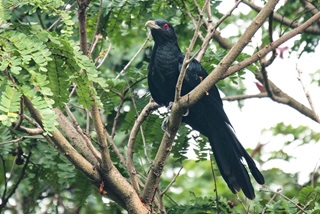 Male, Photo credit: Jeremy Yeo Wei Liang (NParks) Male, Photo credit: Jeremy Yeo Wei Liang (NParks) |
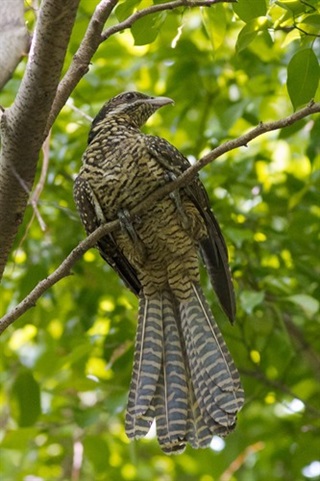 Female, Photo credit: Francis Yap, NParks Flora&FaunaWeb Female, Photo credit: Francis Yap, NParks Flora&FaunaWeb |
| Scientific name: | Eudynamus scolopacea |
| Common name: | Asian Koel |
| Family: | Cuculidae |
 44 cm 44 cm |
 What does it look like?
What does it look like?
This member of the cuckoo family is a large bird that has bright red eyes and a pale beak. The males have an entirely glossy black plumage, while females are brown with white and light brown spots.
 Ecology, Habitat and Distribution
Ecology, Habitat and Distribution
Diet and Behaviour
They are omnivores and feed on a variety of food. Like other cuckoos, they are brood parasites that lay their eggs in the nests of other birds, relying on the unsuspecting foster parents to raise their chicks. In Singapore, their host is the introduced House Crow (Corvus splendens). As the koel chicks hatch and force the crow chicks out of the nest, the Asian Koel acts as an important natural control for Singapore’s crow population.
Where are they found?
These birds are found in a wide range of habitats from urban areas to secondary forests.
Did you know?
They are infamous for their namesake loud, high pitched ‘ko-el’ call which can be heard at any time of the day.
Pink-necked Green Pigeon
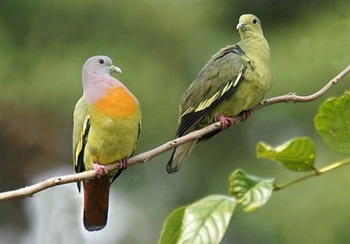 Male (left) and female (right), Photo credit: Cai Yixiong, NParks Flora&FaunaWeb Male (left) and female (right), Photo credit: Cai Yixiong, NParks Flora&FaunaWeb |
| Scientific name: | Treron vernans |
| Common name: | Pink-necked Green Pigeon |
| Family: | Columbidae |
 25–30 cm 25–30 cm |
 What does it look like?
What does it look like?
It is sexually dimorphic, and males can be easily distinguished by their bright pink neck and orange lower breast. Females are uniformly green.
 Ecology, Habitat and Distribution
Ecology, Habitat and Distribution
Diet and Behaviour
They are frugivorous, with large flocks often gathering at fruiting trees. They feed on a wide variety of fruits, making them important seed dispersers. They are arboreal and generally prefer to perch on branches of tall trees. Both males and females are involved in the incubation of eggs and care of young chicks.
Where are they found?
These birds can be found in our forests, mangroves, parks and urban areas. They are widespread throughout Southeast Asia.
Zebra Dove
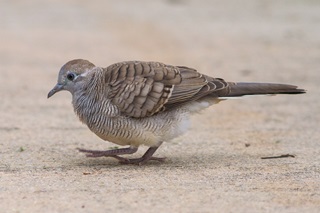 Photo credit: Francis Yap Photo credit: Francis Yap |
| Scientific name: | Geopelia striata |
| Common name: | Zebra Dove |
| Family: | Columbidae |
 20–23 cm 20–23 cm |
 What does it look like?
What does it look like?
The upperparts of this small and slender dove are brownish grey with black and white bars. Its underparts are pinkish, with black bars on the sides of its neck, breast and belly. Its forehead, face and throat are a pale grey, with blue around the eyes.
 Ecology, Habitat and Distribution
Ecology, Habitat and Distribution
Diet and Behaviour
Small flocks are often seen quietly foraging on footpaths and lawns in search of grass seeds, which are a main part of their diet. Their nests consist of a simple platform of leaves and grass blades.
Where are they found?
The Zebra Dove is widespread across Singapore and is often seen in urban areas and grasslands. They are found across Southeast Asia.
Did you know?
They are popular pets due to their pleasant call of soft, short ‘coo’ notes. There are even competitions to find the zebra dove with the best-sounding call!
Blue-tailed Bee-eater
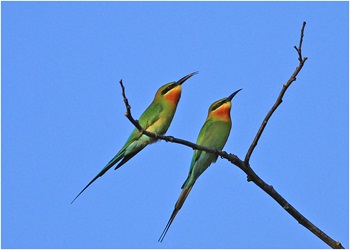 Photo credit: Ong Chwee Sia Photo credit: Ong Chwee Sia |
| Scientific name: | Merops philippinus |
| Common name: | Blue-tailed Bee-eater |
| Family: | Meropidae |
 30 cm (head to streamer) |
 What does it look like?
What does it look like?
It has a long, slightly down-curved black bill, is predominantly greenish in colour and has blue tail feathers with long tail-streamers. Adults have an orange throat with a black eye stripe.
 Ecology, Habitat and Distribution
Ecology, Habitat and Distribution
Diet and Behaviour
These birds feed on a variety of flying insects such as dragonflies, bees and large flies which are caught mid-flight. They like to perch on branches of tall, exposed trees and even antennae when searching for prey. When they catch a bee, they beat it against a branch to remove its sting before consuming it whole.
Where are they found?
These birds are migratory and can be commonly found in a wide range of habitats between the months of October and April. They breed in northern Asia and migrate south during the northern winter months.
Blue-throated Bee-eater
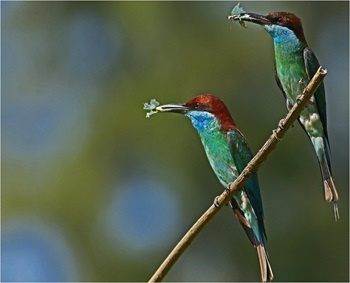 Photo credit: Ong Chwee Sia Photo credit: Ong Chwee Sia |
| Scientific name: | Merops viridis |
| Common name: | Blue-throated Bee-eater |
| Family: | Meropidae |
 28 cm (head to streamer) 28 cm (head to streamer) |
 What does it look like?
What does it look like?
A mix of brown, green and blue makes this bee-eater easy to identify. Adult Blue-throated Bee-eaters have mostly bluish green bodies with a dark chestnut crown, black eye stripe and namesake blue throat.
 Ecology, Habitat and Distribution
Ecology, Habitat and Distribution
Diet and Behaviour
Its diet and behaviour are largely similar to that of the migratory Blue-tailed Bee-eater.
Where are they found?
This species differs from the migratory Blue-tailed Bee-eater in that it breeds in Singapore and disperses to Indonesia during the non-breeding season. They are mainly found in wooded areas and grasslands. This species is also present in many parts of Southeast Asia.
Did you know?
They practise asynchronous brooding, where chicks hatch at different times. This often results in siblicide, where the oldest and largest chick often competes with its younger siblings for food, usually wounding or even killing them.
Rose-ringed Parakeet
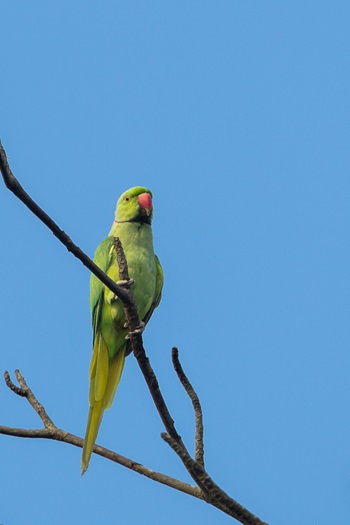 Male, Photo credit: Francis Yap, NParks Flora&FaunaWeb Male, Photo credit: Francis Yap, NParks Flora&FaunaWeb |
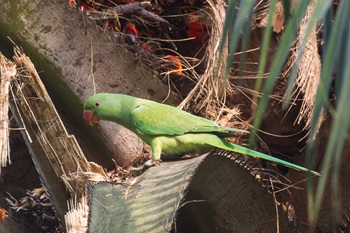 Female, Photo credit: Francis Yap, NParks Flora&FaunaWeb Female, Photo credit: Francis Yap, NParks Flora&FaunaWeb |
| Scientific name: | Psittacula krameri |
| Common name: | Rose-ringed Parakeet |
| Family: | Psittacidae |
 42 cm 42 cm |
 What does it look like?
What does it look like?
It is sexually dimorphic. The male has a distinct black neck ring, which is not present in females.
 Ecology, Habitat and Distribution
Ecology, Habitat and Distribution
Diet and Behaviour
They are frugivores that feed on a wide range of fruits.
Where are they found?
This is an introduced species which originated with escapees from the pet trade. They are now widely distributed across Singapore. Their native range includes the Indian Subcontinent and northern Southeast Asia, but feral populations exist in many other countries.
Yellow-vented Bulbul
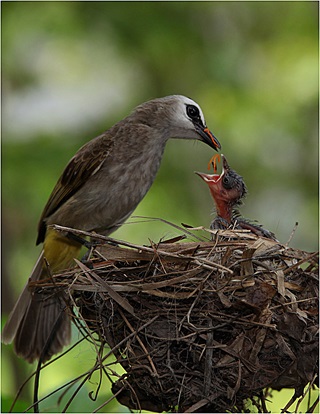 Photo credit: Ong Chwee Sia Photo credit: Ong Chwee Sia |
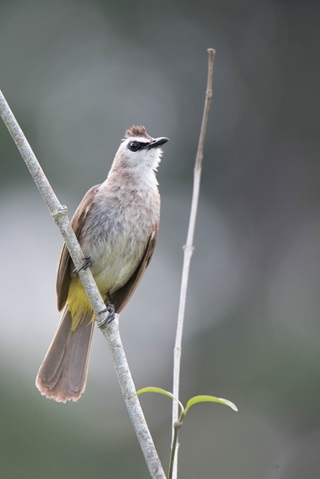 Photo credit: Jeremy Yeo Wei Liang (NParks) Photo credit: Jeremy Yeo Wei Liang (NParks) |
| Scientific name: | Pycnonotus goiavier |
| Common name: | Yellow-vented Bulbul |
| Family: | Pycnonotidae |
 20 cm 20 cm |
 What does it look like?
What does it look like?
As its name implies, it has a yellow vent on the underside of its tail. It is otherwise mainly brown but has a white face with a black band between the eyes and the bill.
 Ecology, Habitat and Distribution
Ecology, Habitat and Distribution
Diet and Behaviour
They are omnivores that feed on berries, nectar and small animals. They are often seen in pairs foraging for food. They build well-camouflaged cup-shaped nests out of plant matter.
Where are they found?
They can be found in a wide variety of habitats across Singapore and throughout Southeast Asia.
Did you know?
The name “Bulbul” comes from an Arabic word meaning “Nightingale”, which alludes to their bubbly calls. However, bulbuls are not related to nightingales.
Malaysian Pied Fantail
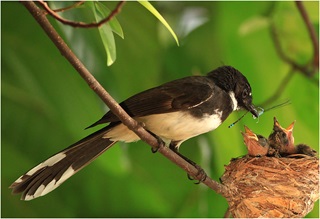 Photo credit: Ong Chwee Sia Photo credit: Ong Chwee Sia |
| Scientific name: | Rhipidura javanica |
| Common name: | Malaysian Pied Fantail |
| Family: | Rhipiduridae |
 17.5–19.5 cm 17.5–19.5 cm |
 What does it look like?
What does it look like?
Like other members of its family, this bird has a distinctive fan-shaped tail. It has largely black upperparts and white underparts with a broad black band across its breast.
 Ecology, Habitat and Distribution
Ecology, Habitat and Distribution
Diet and Behaviour
These birds move rapidly through the understorey, fanning their tails as they go. They are often seen foraging together with other small insect-eating birds.
Where are they found?
Once found primarily in mangroves, this species has colonised many parks in Singapore, particularly those with large, wooded water bodies like Jurong Lake Gardens. They are also widely distributed across many parts of Southeast Asia.
Did you know?
The Malaysian Pied Fantail is called Murai Gila, or “crazy thrush” in Malay due to its disjointed song and frantic feeding behaviour.
Asian Glossy Starling
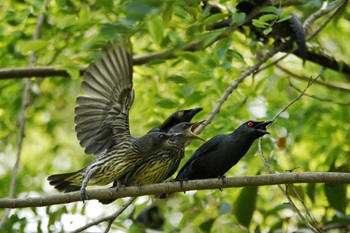 Photo credit: Perlyn Chng Photo credit: Perlyn Chng |
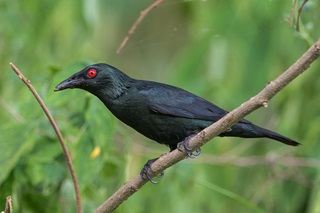 Photo credit: Francis Yap Photo credit: Francis Yap |
| Scientific name: | Aplonis panayensis |
| Common name: | Asian Glossy Starling |
| Family: | Sturnidae |
 22–25 cm 22–25 cm |
 What does it look like?
What does it look like?
Adults have a uniformly glossy green plumage that appears black in poor light. Its distinctive feature is its bright red eyes. Juveniles are greyish brown with white underparts that sport bold dark streaks. They may look similar to the Asian Koel at first glance but are much smaller in size with shorter tails.
 Ecology, Habitat and Distribution
Ecology, Habitat and Distribution
Diet and Behaviour
These highly social omnivores often congregate in large, noisy flocks in fruiting trees.
Where are they found?
One of Singapore’s most abundant birds, the Asian Glossy Starling occurs in all habitats across the island. It is widely distributed across Southeast Asia.
Savanna Nightjar
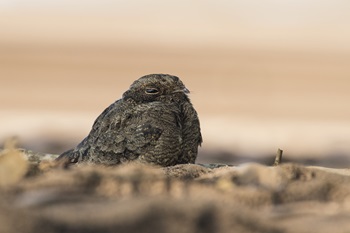 Photo credit: Loke Peng Fai Photo credit: Loke Peng Fai |
| Scientific name: | Caprimulgus affinis |
| Common name: | Savanna Nightjar |
| Family: | Caprimulgidae |
 25 cm 25 cm |
 What does it look like?
What does it look like?
This nocturnal bird has large eyes and brownish grey upperparts irregularly interspersed with pale brown speckles. Its underparts are brown with numerous fine bars.
 Ecology, Habitat and Distribution
Ecology, Habitat and Distribution
Diet and Behaviour
These nocturnal birds hunt for flying insects and are rarely spotted in the day when sleeping motionless on the ground. Their plumage provides excellent camouflage among the leaf litter, keeping them concealed while they roost.
Where are they found?
They are mainly found in grasslands and open country and are distributed across the Indian Subcontinent and Southeast Asia.
Did you know?
They lay their eggs directly on the ground in grasslands, so watch your step when you are walking across an open grassland! The Grasslands at Jurong Lake Gardens was created specially to cater to birds like the Savanna Nightjar.
Brown Shrike
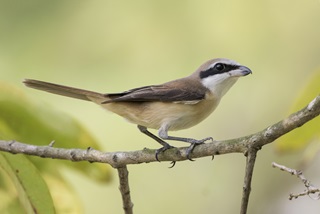 Photo credit: Loke Peng Fai Photo credit: Loke Peng Fai |
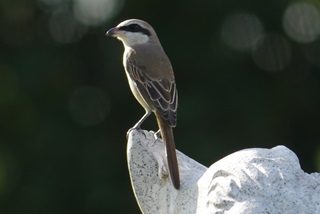 Photo credit: Perlyn Chng Photo credit: Perlyn Chng |
| Scientific name: | Lanius cristatus |
| Common name: | Brown Shrike |
| Family: | Laniidae |
 19–20 cm 19–20 cm |
 What does it look like?
What does it look like?
This migratory bird sports a distinctive “bandit mask” comprising a black stripe through its eyes. It has brown upperparts with a creamy underside and rufous flanks. Females tend to have fine scalloping on their undersides and a dark brown mask.
 Ecology, Habitat and Distribution
Ecology, Habitat and Distribution
Diet and Behaviour
They feed on a range of small animals from insects to rats.
Where are they found?
Brown Shrikes breed in northern and eastern Asia and fly down to spend the winter in the Indian subcontinent and Southeast Asia. They are commonly seen in Singapore during the winter months. They prefer open habitats like parks and grasslands.
Did you know?
They are stone-cold killers that impale their prey! They skewer their prey on the thorns of plants and eat them like meat on a satay stick.
Common Tailorbird
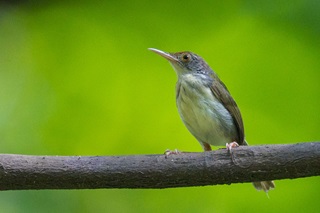 Photo credit: Francis Yap Photo credit: Francis Yap |
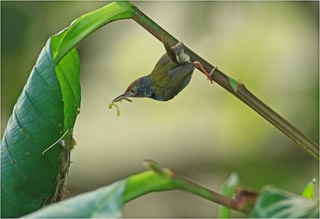 Weaving its nest. Photo credit: Ong Chwee Sia Weaving its nest. Photo credit: Ong Chwee Sia |
| Scientific name: | Orthotomus sutorius |
| Common name: | Common Tailorbird |
| Family: | Cisticolidae |
 10–13 cm 10–13 cm |
 What does it look like?
What does it look like?
The Common Tailorbird is a small bird that has olive brown upperparts and wings with a rufous patch on the head between its eyes and beak. A male in breeding plumage also has an elongated tail and a dark patch on its neck.
 Ecology, Habitat and Distribution
Ecology, Habitat and Distribution
Diet and Behaviour
These small, active birds are insectivores that forage in dense shrubbery in search of prey. They get their name from their unique method of making their nests by weaving and sewing the edges of two large leaves together using plant fibre or spider silk.
Where are they found?
A common garden bird, they are found throughout Singapore. They have a widespread range that includes both the Indian Subcontinent and Southeast Asia.
Did you know?
The character Darzee in “Rikki-Tikki-Tavi”, one of the stories in the Jungle Book series by Rudyard Kipling, is a tailorbird. The name “Darzee” comes from the Urdu word for tailor.
Ashy Tailorbird
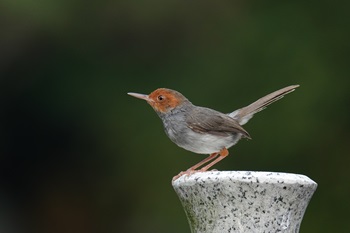 Photo credit: Tan Yip Cheong Photo credit: Tan Yip Cheong |
| Scientific name: | Orthotomus ruficeps |
| Common name: | Ashy Tailorbird |
| Family: | Cisticolidae |
 11 cm 11 cm |
 What does it look like?
What does it look like?
The Ashy Tailorbird is a small bird that has slate grey plumage with a chestnut patch on its face, and a white belly. Females have a much duller colouration.
 Ecology, Habitat and Distribution
Ecology, Habitat and Distribution
Diet and Behaviour
They have similar eating and behavioural habits to the Common Tailorbird.
Where are they found?
The Ashy Tailorbird was originally a mangrove species but has adapted well to urban wetlands. They are now found in many parks containing water bodies such as Jurong Lake Gardens. Elsewhere, they are widely distributed across Southeast Asia.
Pacific Swallow
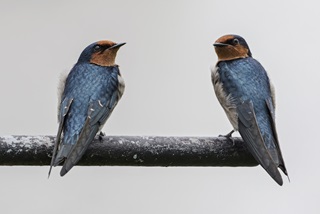 Photo credit: Loke Peng Fai Photo credit: Loke Peng Fai |
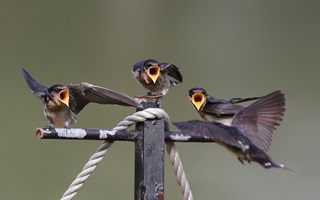 Photo credit: Perlyn Chng Photo credit: Perlyn Chng |
| Scientific name: | Hirundo tahitica |
| Common name: | Pacific Swallow |
| Family: | Hirundinidae |
 13 cm 13 cm |
 What does it look like?
What does it look like?
The only resident species of swallow in Singapore, it sports metallic blue upperparts with an orange forehead, throat and upper breast. It is mostly spotted in flight, often in small groups.
 Ecology, Habitat and Distribution
Ecology, Habitat and Distribution
Diet and Behaviour
It is a fast flyer that feeds on insects while airborne. Its neat, cup-shaped nest is built with mud pellets under a cliff ledge or on man-made structures like buildings, bridges and towers.
Where is it found?
The Pacific Swallow has a wide distribution across much of the Eastern Hemisphere. In Singapore, it is a common resident that is found in many habitats.
Common Iora
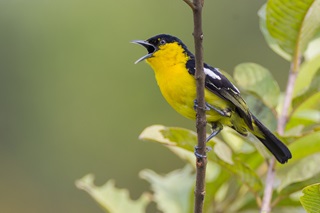 Male. Photo credit: Francis Yap Male. Photo credit: Francis Yap |
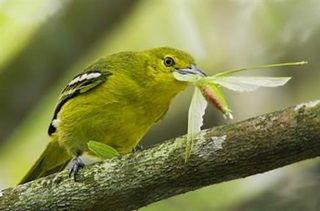 Female. Photo credit: Cai Yixiong, NParks Flora&Fauna Web Female. Photo credit: Cai Yixiong, NParks Flora&Fauna Web |
| Scientific name: | Aegithina tiphia |
| Common name: | Common Iora |
| Family: | Aegithinidae |
 12–14 cm 12–14 cm |
 What does it look like?
What does it look like?
It is sexually dimorphic, with the bright yellow males sporting a black cap and back during breeding season, while females are entirely olive green. Both sexes have yellow underparts and two white bars on their black wings.
 Ecology, Habitat and Distribution
Ecology, Habitat and Distribution
Diet and Behaviour
They actively forage for food in the canopy, moving through the crowns of trees while looking for insects.
Where are they found?
It is common in our parks and gardens and can be seen along the tree-lined roads in our heartlands as well.
The Common Iora can be found in the Indian subcontinent, southwest China and Southeast Asia in mangroves, secondary growth and parks.
Black-naped Oriole
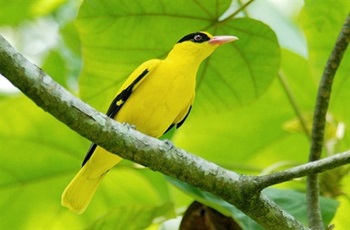 Photo credit: Cai Yixiong, NParks Flora&Fauna Web Photo credit: Cai Yixiong, NParks Flora&Fauna Web |
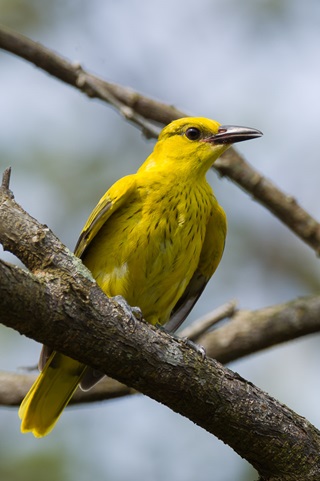 Photo credit: Francis Yap Photo credit: Francis Yap |
| Scientific name: | Oriolus chinensis |
| Common name: | Black-naped Oriole |
| Family: | Oriolidae |
 27 cm 27 cm |
 What does it look like?
What does it look like?
One of the most common bird species in Singapore, the Black-naped Oriole has bright yellow plumage with some black on its wings and a pinkish bill. Its name comes from a black band across its eyes that runs down to its nape. Females have a slightly greener tinge. Their calls are a melodious ‘too-diddlyoo’ whistle, but they also make harsh rasping noises at times.
 Ecology, Habitat and Distribution
Ecology, Habitat and Distribution
Diet and Behaviour
The Black-naped Oriole feeds mainly on fruits and insects.
Where is it found?
It can be seen in wooded habitats all over the island. It can also be found in South Asia and many parts of Southeast Asia.
Did you know?
Black-naped Orioles have a dark side to them! During breeding season, they are skilled nest raiders that snatch unguarded chicks from the nests of smaller birds to feed to their own young.
Oriental Pied Hornbill
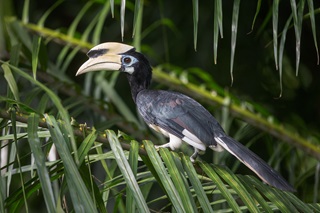 Photo credit: Francis Yap Photo credit: Francis Yap |
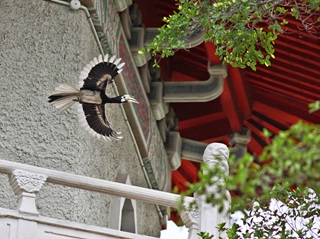 Photo credit: Perlyn Chng Photo credit: Perlyn Chng |
| Scientific name: | Anthracoceros albirostris |
| Common name: | Oriental Pied Hornbill |
| Family: | Bucerotidae |
 70 cm 70 cm |
 What does it look like?
What does it look like?
These large birds are unmistakable. Both sexes are largely black with a white belly. Males have a very pronounced black-tipped casque on its clean yellowish bill. Females have a much smaller casque with black patches.
 Ecology, Habitat and Distribution
Ecology, Habitat and Distribution
Diet and Behaviour
They feed mainly on fruits but are also known to feed on insects and other small animals. They are important to the ecosystem as they disperse seeds that are too large for smaller bird species to eat.
Oriental Pied Hornbills are gregarious and often travel in noisy flocks. They require a large tree to nest. The female seals herself inside a suitably sized hole in a tree with a plaster made of mud and plant fibres. The male forages for food alone, while the female guards the nest to deter predators from stealing their eggs for food.
Where are they found?
The Oriental Pied Hornbill has a wide distribution from the Indian Subcontinent to Southeast Asia. In Singapore, the species is a prime example of successful conservation efforts. It was rediscovered on Pulau Ubin in 1994 and is now found across most of Singapore.
Did you know?
The Singapore Hornbill Project was initiated in 2004 by NParks, Jurong Bird Park and local researchers with the goal of bringing hornbills back to Singapore. The project was extremely successful and by the time it ended in 2012, the Oriental Pied Hornbill had become a well-known and endearing avian icon.
 Conservation Status
Conservation Status
It is listed as Critically Endangered in the Singapore Red Data Book (2008). After an absence of over a century, a pair was observed on Pulau Ubin in 1994. Thanks to extensive conservation efforts, the local hornbill population is on the rise.
Oriental Magpie-Robin
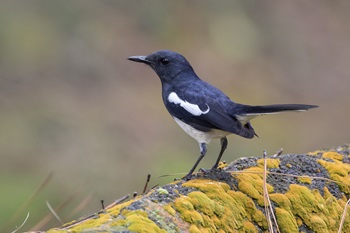 Photo credit: Loke Peng Fai Photo credit: Loke Peng Fai |
| Scientific name: | Copsychus saularis |
| Common name: | Oriental Magpie-Robin |
| Family: | Muscicapidae |
 19 cm 19 cm |
 What does it look like?
What does it look like?
It has distinctive black and white plumage that resembles a magpie. Males have a glossy black head, breast and upperparts, while the rest of the underparts are white. It also has a distinct white wing bar. Females are similar to males but have a slate grey head, breast and upperparts.
 Ecology, Habitat and Distribution
Ecology, Habitat and Distribution
Diet and Behaviour
It forages on insects mainly on the ground, where it can be seen hopping around with its tail raised.
Where are they found?
This bird is widely distributed across Southeast Asia. In Singapore, they used to be a popular cage bird and were heavily trapped. In more recent times, the population appears to be recovering and they are now present in many parks and wooded areas.
 Conservation Status
Conservation Status
It is listed as Endangered in the Singapore Red Data Book (2008). In recent years, the local population appears to be gradually increasing.
Javan Myna
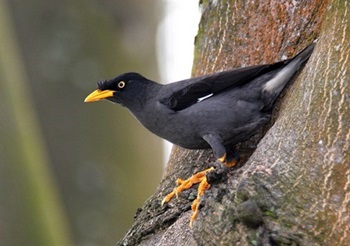 Photo credit: Cai Yixiong, NParks Flora&Fauna Web Photo credit: Cai Yixiong, NParks Flora&Fauna Web |
| Scientific name: | Acridotheres javanicus |
| Common name: | Javan Myna |
| Family: | Sturnidae |
 24–25 cm 24–25 cm |
 What does it look like?
What does it look like?
The Javan Myna is Singapore’s most recognisable bird. It has slate grey plumage with a glossy black head, wings and tail. Its eyes, bill and feet are orange yellow.
 Ecology, Habitat and Distribution
Ecology, Habitat and Distribution
Diet and Behaviour
They have adapted well to the urban environment by exploiting food sources such as leftover food in hawker centres and food waste. Outside of urban environments, they forage for insects and other invertebrates on the ground by probing the soil with their bills.
Where are they found?
In Singapore, it is by far the most abundant bird and occurs in all habitats. The Javan Myna is not native to Singapore but was introduced from Java and Bali. The introduced population has since colonised most of Peninsular Malaysia and southern Thailand.
Did you know?
Ironically, this bird is very rare in its native range of Java and Bali as it is heavily trapped for the pet trade there.
 Conservation Status
Conservation Status
This bird is classified as “Vulnerable” by the IUCN as it is heavily trapped by humans in its native range, despite being regarded as an introduced pest in Singapore.
Common Myna
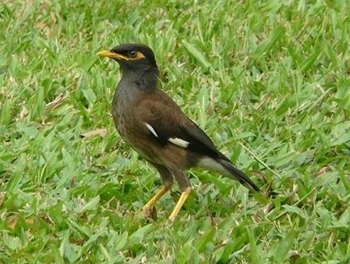 Photo credit: Cheryl Chia, NParks Flora&Fauna Web Photo credit: Cheryl Chia, NParks Flora&Fauna Web |
| Scientific name: | Acridotheres tristis |
| Common name: | Common Myna |
| Family: | Sturnidae |
 24–27 cm 24–27 cm |
 What does it look like?
What does it look like?
While similar to the more common Javan Myna, this species has brown, not slate grey plumage, and has prominent yellow facial skin around the eye. When juveniles moult their head feathers, they often look bald, causing many to mistake them for sick birds.
 Ecology, Habitat and Distribution
Ecology, Habitat and Distribution
Diet and Behaviour
It feeds mainly on the ground for insects and leftover scraps. It isn’t picky about its nesting sites and will use any cavity where it can pile nesting material into, including cracks in buildings or air conditioning units.
Where are they found?
These birds are native to the Indian subcontinent and Southeast Asia. They are also native to Singapore and are found in a wide variety of habitats, but in far smaller numbers than the Javan Myna.
Did you know?
The Common Myna, contrary to its name, is not common in Singapore and is largely outcompeted by the introduced and more aggressive Javan Myna.
Banner: Zebra Dove. Photo credit: Ambarish Deshmukh



